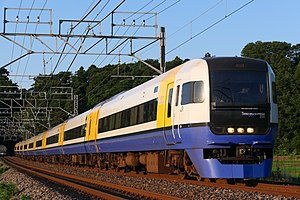railroad.wikisort.org - Train
The Shiosai (しおさい) is a limited express train service in Japan operated by East Japan Railway Company (JR East). It runs from Tokyo and Shinjuku to Chōshi on the Bōsō Peninsula in Chiba Prefecture.
Station stops
Shiosai services operate over the Sōbu Main Line, stopping at the stations listed below. No services operate as "Local" all-stations services in any section; this characteristic is different from that of Wakashio ltd.exp..[1][2][3]
Tokyo - Kinshichō - Chiba - Sakura - Yachimata - Narutō - Yokoshiba - Yōkaichiba - Asahi - Iioka - Chōshi
- No.1 & 12 trains also stop at Funabashi station.
- No.2, 4 & 13 trains also stop at Yotsukaidō station.
Rolling stock

- 255 series 9-car EMUs (since 10 December 2005)
- E257-500 series 5/10-car EMUs
Shiosai services are operated using Makuhari-based 9-car 255 series EMU and 10-car E257-500 series EMU formations. The E257-500 series formations have no Green (first class) cars.[4][2]
Past rolling stock
- 183 series EMUs (10 March 1975 – 2005)
Formations
Trains are formed as shown below, with car 1 at the Tokyo end.[1][5]
9-car 255 series
| Car No. | 1 | 2 | 3 | 4 | 5 | 6 | 7 | 8 | 9 |
|---|---|---|---|---|---|---|---|---|---|
| Numbering | KuHa 254 | MoHa 254 | MoHa 255 | SaRo 255 | SaHa 254 | SaHa 255 | MoHa 254 | MoHa 255 | KuHa 255 |
| Accommodation | Non-reserved | Non-reserved | Non-reserved | Green | Reserved | Non-reserved | Non-reserved | Non-reserved | Non-reserved |
As of 2019, cars no. 2 and 3 are reserved on some services.[2]
5+5-car E257 series
| Car No. | 1 | 2 | 3 | 4 | 5 | 6 | 7 | 8 | 9 | 10 | |
|---|---|---|---|---|---|---|---|---|---|---|---|
| Numbering | KuHa E256-500 | MoHa E257-1500 | MoHa E256-500 | MoHa E257-500 | KuHa E257-500 | KuHa E256-500 | MoHa E257-1500 | MoHa E256-500 | MoHa E257-500 | KuHa E257-500 | |
| Accommodation | Non-reserved | Non-reserved | Non-reserved | Non-reserved | Non-reserved | Non-reserved | Reserved | Non-reserved | Non-reserved | Non-reserved |
Past formations

Trains were originally formed of 9-car 183 series EMUs, including one Green car, or 6-car sets with no Green car,[6] but from December 1994, services were formed of 8-car 183 series sets with the Green car removed, as shown below.[7][8]
8-car 183 series
| Car No. | 1 | 2 | 3 | 4 | 5 | 6 | 7 | 8 |
|---|---|---|---|---|---|---|---|---|
| Accommodation | Reserved | Reserved | Non-reserved | Non-reserved | Non-reserved | Non-reserved | Non-reserved | Non-reserved |
History

The Shiosai service was introduced from 10 March 1975 following the completion of electrification of the Sōbu Main Line in October 1974, using 9-car 183 series EMUs, replacing five of the seven daily diesel-powered Inubō (犬吠) express services that operated between Shinjuku/Ryōgoku and Chōshi.[8]
From the start of the November 1982 timetable revision, further 183 series EMUs were drafted in, displaced from Toki limited express services following the opening of the Joetsu Shinkansen,[9] and the remaining Inubō express services were discontinued and absorbed into the Shiosai services, giving seven return workings daily.[8]
From the start of the revised timetable on 10 December 2005, 255 series 9-car EMUs were introduced on Shiosai services.[5] From the same date, services were made entirely no-smoking.[5]
From the start of the 14 March 2015 timetable revision, all Shiosai services started and terminated at Tokyo Station, with no services operating from Shinjuku.[10]
See also
- List of named passenger trains of Japan
References
- JR Timetable. Japan: Kotsu Shimbunsha. April 2016. p. 95–95, 984.
- 千葉を走る列車>しおさい:EAST JAPAN RAILWAY COMPANY Chiba branch Japan
- 千葉を走る列車>わかしお:EAST JAPAN RAILWAY COMPANY Chiba branch Japan
- JR新幹線&特急列車ファイル [JR Shinkansen & Limited Express Train File]. Japan: Kotsu Shimbun. 2008. p. 646. ISBN 978-4-330-00608-6.
- JR電車編成表 2012冬 [JR EMU Formations - Winter 2012]. Japan: Kotsu Shimbunsha. October 2011. pp. 50–51. ISBN 978-4-330-25611-5.
- 国鉄電車編成表1985年版 [JNR EMU Formations - 1985]. Japan: Kotsu Shimbunsha. October 2010. p. 30. ISBN 978-4-330-17610-9.
- こだわりの新幹線&特急列車ガイド [In-depth Shinkansen & Limited Express Guide]. Japan: Ikaros Publishing. August 2000. pp. 84–85. ISBN 4-87149-284-2.
- Teramoto, Mitsuteru (July 2001). 国鉄・JR列車名大辞典 [JNR & JR Train Name Encyclopedia]. Tokyo, Japan: Chuoshoin Publishing Co., Ltd. p. 266. ISBN 4-88732-093-0.
- JR特急列車年鑑2013 [Limited Express Annual 2013]. Tokyo, Japan: Ikaros Publications Ltd. 20 December 2012. p. 166. ISBN 978-4-86320-654-0.
- JR Timetable. Japan: Kotsu Shimbunsha. February 2015. EAN 4910053110259.
External links
| Wikimedia Commons has media related to Shiosai. |
- JR East 255 series Shiosai/Wakashio/Sazanami (in Japanese)
- JR East E257 series Wakashio/Sazanami/Shiosai/Ayame (in Japanese)
Другой контент может иметь иную лицензию. Перед использованием материалов сайта WikiSort.org внимательно изучите правила лицензирования конкретных элементов наполнения сайта.
WikiSort.org - проект по пересортировке и дополнению контента Википедии

